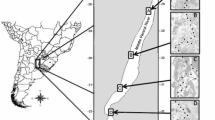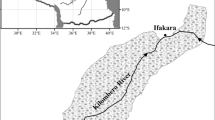Abstract
The study evaluates the potential for bird species assemblages to serve as indicators of biological integrity of rangelands in the Great Basin in much the same way that fish and invertebrate assemblages have been used as indicators in aquatic environments. Our approach was to identify metrics of the bird community using relatively simple sampling methods that reflect the degree of rangeland degradation and are consistent over a variety of vegetation types and geographic areas. We conducted the study in three range types (i.e., potential natural plant community types) in each of two widely separated areas of the Great Basin: south-eastern Idaho (sagebrush steppe range types) and west-central Utah (salt-desert shrub range types). Sites were selected in each range type to represent three levels of grazing impact, and in Idaho included sites modified for crested wheatgrass production. Birds were sampled by point counts on 9 100-m radius plots at 250-m spacing on each of 20 sites in each area during the breeding season. In sagebrush-steppe, 964 individuals in 8 species of passerine birds were used in analyses. Five metrics were significantly related to impact class, both when analyzed within range type and when analyzed with all range types combined. Species richness, relative abundance of shrub obligate species, and relative abundance of Brewer's sparrow were generally lower for the higher impact classes, whereas the reverse was true for dominance by a single species and for relative abundance of horned larks. In contrast, total number of individuals did not differ significantly as a function of impact class. In salt-desert shrub, a total of 843 birds in 4 species were included in analyses, 98% of which were horned larks. None of the metrics identified above was significantly related to impact class. Two metrics for breeding birds in sagebrush steppe (species richness and dominance) showed little overlap between values for the extremes of impact class, and thus they have potential as indicators of biological integrity. However, the sensitivity of these metrics appears to be greatest at the high impact end of the spectrum, which suggests they may have limited utility in distinguishing between sites having light and moderate impact.
Similar content being viewed by others
References
Adamus, P. R. and Brandt, K.: 1990, Impacts on Quality of Inland Wetlands of the United States: a Survey of Indicators, Techniques, and Applications of Community-level Biomonitoring Data, EPA/600/3-90/073, U.S Environmental Protection Agency, Office of Research and Development, Washington, DC. 406 pp.
Angermeier, P. L. and Karr, J. R.: 1994, ‘Biological integrity versus biological diversity as policy directives', Bioscience 44, 690–697.
Best, L. B.: 1972, ‘First-year effects of sagebrush control on two sparrows', J. Wildl. Manage. 36, 534–544.
Blaisdell, J. P., Murray, R. B. and McArthur, E. D.: 1982, Managing Intermountain Rangelands – Sagebrush-grass Ranges, Gen. Tech. Rep. INT-134, Ogden, UT: U.S. Department of Agriculture, Forest Service, Intermountain Forest and Range Experiment Station. 41 pp.
Blaisdell, J. P. and Holmgren, R. C.: 1984, Managing Intermountain Rangelands – Salt-desert Shrub Ranges, Gen. Tech. Rep. INT-163, Ogden, UT: U.S. Department of Agriculture, Forest Service, Intermountain Forest and Ragne Experiment Station. 52 pp.
Bock, C. E., Bock, J. J., Kenney, W. R. and Hawthorne, V. M.: 1984, ‘Responses of birds, rodents, and vegetation to livestock exclosure in a semidesert grassland site', J. Range Management 37, 239–242.
Bock, C. E., Saab, V. A., Rich, T. D. and Dobkin, D. S.: 1993, ‘Effects of Livestock Grazing on Neotropical Migratory Landbirds in Western North America', in: D. M. Finch and P. W. Stangel (eds.), Status and Management of Neotropical Migratory Birds, USDA Forest Service Gen. Tech. Rep. RM–229, Fort Collins, Colorado, pp. 296–309.
Bonham, C. D.: 1989, Measurements for Terrestrial Vegetation, John Wiley, New York.
Braun, C. E., Baker, M. F., Eng, R. L., Gashwiler, J. S. and Schroeder, M. H.: 1976, ‘Conservation committee report on effects of alteration of sagebrush communities on the associated avifauna', Wilson Bull. 88, 165–171.
Brown, D. E., Lowe, C. H. and Pase, C. P.: 1979, ‘A digitized classification system for the biotic communities of North America, with community (series) and association examples for the Southwest', Journal of the Arizona-Nevada Academy of Science 14 (Supplement 1), 1–16.
Canterbury, G. E., Martin, T. E., Petit, D. R., Petit, L. J. and Bradford, D. F.: ‘Bird communities and habitat as ecological indicators of forest condition in regional monitoring', Manuscript in review.
Castrale, J. S.: 1982, ‘Effects of two sagebrush control methods on nongame birds', J. Wildl. Manage. 46, 945–952.
Cody, M.: 1985, ‘Habitat Selection in Grassland and Open-Country Birds', in: M. L. Cody (ed.), Habitat Selection in Birds, Academic Press, New York, pp. 191–225.
Croonquist, M. J. and Brooks, R. P.: 1991, ‘Use of avian and mammalian guilds as indicators of cumulative impacts in riparian-wetland areas', Environmental Management 15, 701–704.
Dobler, F. C.: 1994, ‘Washington State Shrub-Steppe Ecosystem Studies with Emphasis on the Relationship Between Nongame Birds and Shrub and Grass Cover Densities', in: S. B. Monsen and S. G. Kitchen (eds.), Proceedings – Ecology and Management of Annual Rangelands, USDA Forest Service General Technical Report INT-GTR-313, pp. 149–161.
Ehrlich, P. R., Dobkin, D. S. and Wheye, D.: 1988, The Birder's Handbook, Simon and Schuster, New York.
Fore, L. S., Karr, J. R. and Wisseman, R.W.: 1996, ‘Assessing invertebrate responses to human activities: evaluating alternative approaches', Journal of the North American Benthological Society 15, 212–231.
Holmgren, R. C.: 1973, ‘The desert experimental range: description, history, and program', in: Arid Shrublands–Proceedings of the Third Workshop of the U.S./Australia Rangelands Panel, Soc. Range Manage., Denver, CO., pp. 18–22.
Karr, J. R.: 1991, ‘Biological integrity: a long-neglected aspect of water resource management', Ecological Applications 1, 66–84.
Karr, J. R.: 1993, ‘Defining and assessing ecological integrity: beyond water quality', Environmental Toxicology and Chemistry 12, 1521–1531.
Karr, J. R. and Dudley, D. R.: 1981, ‘Ecological perspective on water quality goals', Environmental Management 5, 55–68.
Knick, S. T. and Rotenberry, J. T.: 1995, ‘Landscape characteristics of fragmented shrubsteppe habitats and breeding passerine birds', Conservation Biology 9, 1059–1071.
Medin, D. E.: 1986, ‘Grazing and passerine breeding birds in a Great Basin low–shrub desert', Great Basin Nat. 46, 567–572.
MacMahon, J. A.: 1985, Deserts, Alfred A. Knopf, New York. 638 pp.
Moors, A. K.: 1993, Towards an Avian Index of Biotic Integrity for Lakes, Masters of Science Thesis in Wildlife Management, University of Maine, Orono. 184 p.
Morrison, M. L.: 1986, ‘Bird populations as indicators of environmental change', Current Ornithology 5, 429–451.
National Research Council: 1994, Rangeland Health: New Methods to Classify, Inventory, and Monitor Rangelands, National Academy Press, Washington, D.C. 180 pp.
Reynolds, T. D. and Trost, C. H.: 1980, ‘The response of native vertebrate populations to crested wheatgrass planting and grazing by sheep', J. Range Manage. 33, 122–125.
Reynolds, T. D. and Trost, C. H.: 1981, ‘Grazing, crested wheatgrass, and bird populations in southeastern Idaho', Northwest Science 55, 225–234.
Saab, V. A., Bock, C. E., Rich, T. D. and Dobkin, D. S.: 1995, ‘Livestock grazing effects in western North America', in: T. E. Martin and D.M. Finch (eds.), Ecology and Management of Neotropical Migratory Birds, pp. 311–353. Oxford Univ. Press, New York. 489 pp.
Schroeder, M. H. and Sturges, D. L.: 1975, ‘The effect on the Brewer's sparrow of spraying big sagebrush', J. Range Manage. 28, 294–297.
Turner, R. M.: 1982, ‘Great basin desertscrub', in: D. E. Brown (ed.), Biotic Communities of the American Southwest – United States and Mexico, pp. 145–155. Desert Plans, vol. 4, Numbers 1–4, 342 pp.
USDA Soil Conservation Service: 1976, National Range Handbook, U.S. Department of Agriculture, Washington, D.C.
Verner, J.: 1984, ‘The guild concept applied to management of bird populations', Environmental Management 8, 1–14.
West, N. E.: 1982, ‘Intermountain salt-desert shrublands', in: Ecosystems of the World, pp. 375–398. Elsevier Scientific, Amsterdam. Vol. 5.
Wiens, J. A.: 1974, ‘Climatic instability and the “ecological saturation” of bird communities in North American grasslands', Condor 76, 385–400.
Wiens, J. A. and Dyer, M. I.: 1975, ‘Rangeland avifaunas: their composition, energetics, and role in the ecosystem', in: Symposium on Management of Forest and Range Habitat for Nongame Birds, pp. 146–182. USDA For. Serv. Gen. Tech. Rep. WO-1.
Wiens, J. A. and Rotenberry, J. T.: 1985, ‘Response of breeding passerine birds to rangeland alteration in a North American shrubsteppe locality', J. Applied Ecology 22, 655–668.
Author information
Authors and Affiliations
Rights and permissions
About this article
Cite this article
Bradford, D.F., Franson, S.E., Neale, A.C. et al. Bird Species Assemblages as Indicators of Biological Integrity in Great Basin Rangeland. Environ Monit Assess 49, 1–22 (1998). https://doi.org/10.1023/A:1005712405487
Issue Date:
DOI: https://doi.org/10.1023/A:1005712405487




